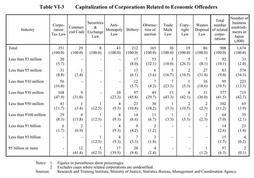| Previous Next Index Image Index Year Selection | |
|
|
The Research and Training Institute of the Ministry of Justice has conducted a survey based on judgment documents and case records to identify the situation of economic offenses related to corporate activities, attributes of offenders and the corporations to which they belonged, results of sentencing, and so on. The survey covers incidents perpetrated in relation to corporate business activities by representatives or employees of corporations who were convicted for Corporation Tax Law violations, Commercial Code violations, bribery, obstruction of auction, Trade Mark Law violations, Copyright Law violations or Wastes Disposal Law violations between January1,1994and December31,1998,or for Securities&Exchange Law or Anti-Monopoly Law violations between April1,1994and December31,1998. In total, the survey covered812cases,1,114persons and511corporations.
1 Businesses and Capitalization of Related Corporations(see Table VI-3 ) By industry, construction had the largest ratio of persons convicted for bribery and obstruction of auction, while finance/insurance has the largest ratio of those convicted for Securities&Exchange Law violations. By level of capitalization,41.5%of the corporations to which the convicts belonged were capitalized at¥10million or more but less than¥30million. Table VI-3 Capitalization of Corporations Related to Economic Offenders 2Status of Offenders By status of offenders, "representative directors, presidents and chairmen"had the largest ratio of the total number of convicts, but"managers other than directors"had the largest ratio of convicts for Anti-Monopoly Law and Commercial Code violations. As regards the relationship between the status of offenders and the capitalization of related companies, corporations with larger capitalization generally had a smaller ratio of"representative directors, presidents and chairmen"among the offenders. However, the share was higher for the largest companies with capitalization of¥5billion or more. 3 Sentencing This section deals with the sentencing handed down to convicted offenders. In total, the execution of sentence was suspended for nearly50%of offenders sentenced to imprisonment with labor for one year or more but less than two years. The ratio of imprisonment without suspension of sentence stood at6.1%. As regards the amount of fines imposed on the corporations to which the convicts belonged, fines for Corporation Tax Law violations amounted to¥10million or more but less than¥50million for76.3%of the corporations. Only7.2%of the corporations were fined less than¥10million. For Anti-Monopoly Law violations, the amount of fines was never below¥40million. A majority of the corporations(58.7%)were fined¥60million or more but less than¥70million. Fines most often amounted to¥2million or more but less than¥2.5million for Trade Mark Law violations(accounting for31.6%of cases), and¥0.5million or more but less than¥1million for Copyright Law and Wastes Disposal Law violations(62.5%and39.1%, respectively). |
